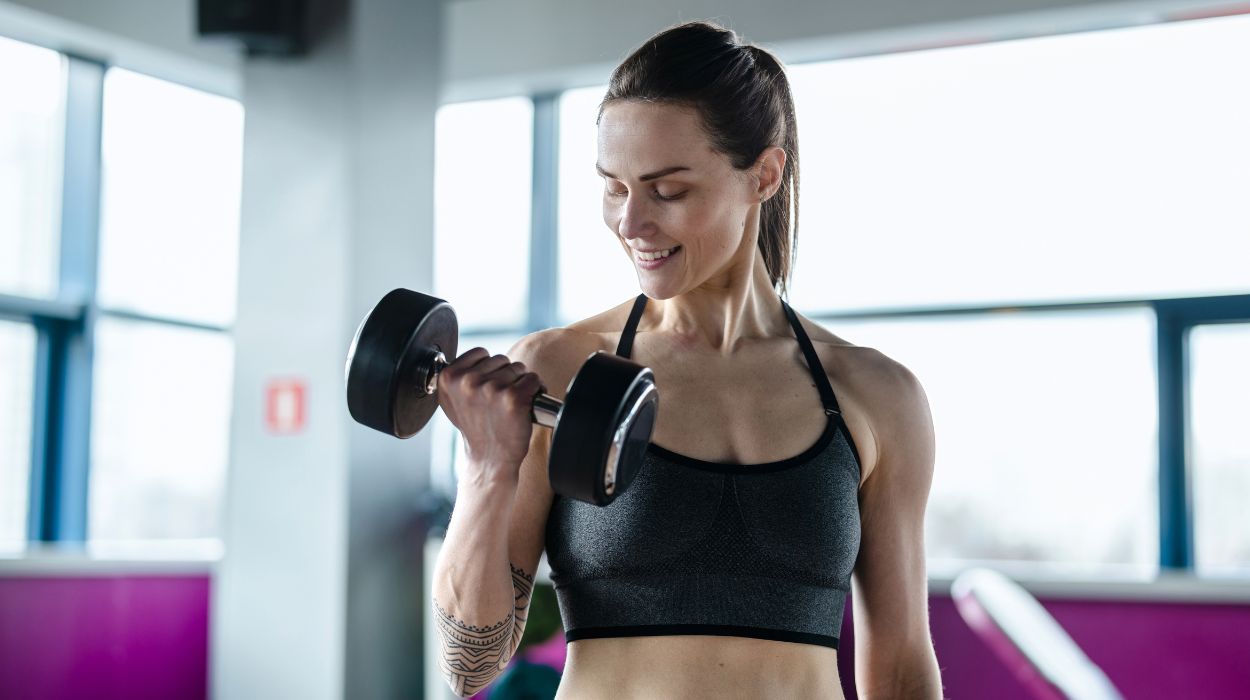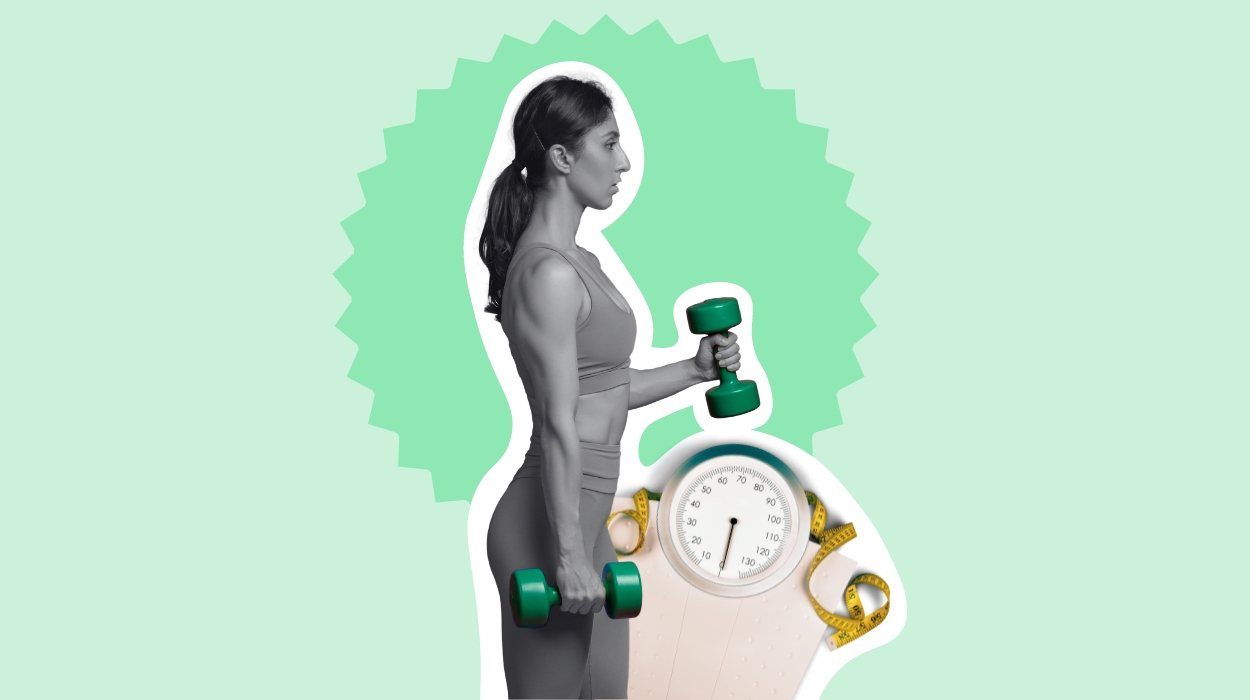Weight training for weight loss may sound contradicting when you first hear it. We tend to think building muscle will cause us to gain weight. But there’s a big difference between gaining body fat and gaining muscle tissue.
Incorporating weight lifting and weight loss allows you to affect multiple muscles simultaneously, making it an effective exercise for your everyday health. This article introduces some of the best strength training exercises for weight loss. We’ll also give you invaluable tips to effectively reach your goals.
Best Weight Training Workout Split
- Upper Body Day: cardio, chest and triceps, shoulders, back and biceps.
- Lower Body Day: glutes and legs.
You can choose the split workout three or four days a week, alternating between upper body and lower body workouts with one rest or active recovery day in between. Choose the split that best fits your schedule and remember to listen to your body and adjust as needed based on your progress and recovery capacity.
Weight Training For Weight Loss: Best Workout Split
Lifting weights has been considered a great form of physical activity for decades. Contrary to popular belief, you don’t have to be a world-famous bodybuilder to experience the benefits of exercise in lowering body fat percentage.
When beginning weight training, it’s crucial to understand reps and sets. Reps refer to how many times you perform an exercise without rest. Meanwhile, sets refer to how many rounds you’ll complete of the exercise.
For example, you might decide to do shoulder presses with a dumbbell. You could do 10 reps for a total of four rounds. Studies have shown it’s best to do 8-12 reps[1] at a time for effective muscle growth.
How much weight you use depends on where you are currently in your fitness journey. It should feel challenging, but it shouldn’t be painful. You may start with lighter weights and transition to heavier weights as your strength improves.
We’ve included some common exercises for both the lower and upper body. Feel free to incorporate these into your exercise routine.
Upper Body Day

No matter what your fitness goals entail, don’t skip upper-body workouts. We know it’s trendy to focus on ways to grow your glutes, but it’s still important to take a total body approach to your health.
The upper body includes the chest, triceps, shoulders, back, biceps, and abdomen. Having a strong core has more benefits than an aesthetically pleasing physique.
Regularly engaging in core strengthening exercises has been shown to improve upper body stability,[2] particularly when performing upper and lower body exercises. Because of this, it may help prevent injury during weight training.
Adding Cardio
It’s common for weight lifters to add cardio on upper body days. It can feel close to impossible to get in cardio after you’ve done a lower-body workout with weights.
Creating a cardio and weight training schedule can help you stay on track. Healthy adults need to get at least 150 minutes of moderate-intensity aerobic activity[3] weekly. This is about 30 minutes daily, five times weekly.
If you are at the gym, you can use the stair climber, treadmill, or elliptical to get in your daily cardio. You can do this before or after your upper body workout, depending on your preference.
We’ve put together a few upper body exercises to get you started and choose a few for your next workout.
Chest And Triceps
The chest and triceps workout day is designed to target and strengthen your chest muscles and triceps, promoting upper body strength and definition. Therefore, this workout day is an excellent choice for individuals looking to enhance their chest and triceps while sculpting a well-defined upper body.
| Exercise | Sets x Reps |
| Dumbbell Bench Press | 2-3 x 10-12 |
| Cable Flyes | 2-3 x 8-10 |
| Cable Push-Downs | 2-3 x 12-15 |
| Tricep Dips | 2-3 x 8-10 |
Shoulders
The shoulders workout workout day is designed to target and sculpt the deltoid muscles for well-defined and balanced shoulders. This workout includes a series of exercises that focus on developing shoulder muscles for strength and aesthetics. Each exercise targets specific parts of the shoulder complex.
| Exercise | Sets x Reps |
| Dumbbell Shoulder Press | 2-3 x 10-12 |
| Dumbbell Lateral Raises | 2-3 x 12-15 |
| Barbell Overhead Press | 2-3 x 8-10 |
| Arnold Press | 2-3 x 10-12 |
Back And Biceps
The back and biceps workout is designed to target and strengthen the muscles of your back and biceps. Helping you to build muscle mass, improve upper body strength, and achieve a balanced upper body and physique, enhancing your overall fitness and appearance.
| Exercise | Sets x Reps |
| Seated Cable Rows | 2-3 x 10-12 |
| Alternating Dumbbell Curls | 2-3 x 8-10 |
| Bent Over Barbell Rows | 2-3 x 8-10 |
| Preacher Curls | 2-3 x 10-12 |
Lower Body Day

The next time you hit the gym, try some of these leg and glute-focused exercises.
Glutes
The glutes workout day is dedicated to strengthening and sculpting your gluteal muscles, helping you achieve a firmer and more defined lower body. The gluteus maximus, commonly called the glutes, is one of the primary hip extensors. Whether you’re looking to sculpt your buttocks or enhance your overall lower body strength, this workout has you covered. Many exercises target this area of the body, with the step-up exercises[4] being one of the best. Here are a few others you can try:
| Exercise | Sets x Reps |
| Barbell Hip-Thrusts | 3-4 x 10-12 |
| Side Lunges with Dumbbells | 3-4 x 12-15 each leg |
| Barbell Squats | 3-4 x 8-10 |
Legs
To train the legs, focus on exercises that target the quads, hamstrings, and calves. Here are a few targeted exercises to try the next time you go to the gym:
| Exercise | Sets x Reps |
| Leg Press | 3-4 x 10-12 |
| Seated Calf Raises | 3-4 x 15-20 |
| Leg Curls | 3-4 x 10-12 |
| Romanian Deadlifts with Dumbbells | 3-4 x 8-10 |
Weight Training Vs. Other Training Weight Loss Methods
Strength training programs are one of the ways you can lose weight effectively. But it isn’t the only option. The good news is you don’t have to spend hours in the gym to lose body weight.
Many studies have shown resistance training[5] to be effective for weight loss alone. However, resistance training combined with aerobic exercise can also result in weight loss.
Something that sets weight training apart from aerobic exercise is that it helps prevent the loss of lean muscle mass and improve your body composition.[6] Beyond health markers, your training schedule affects how your body looks.
Do you want to gain muscle while maintaining lean muscle mass? Or do you want to incorporate cardio exercise to achieve a slimmer appearance? Both can lead to weight loss and improve your total body health.
All bodies are different, and goals will vary. However, weight training alone is still an effective way to burn calories and lose fat. This will help you reach your weight loss goals.
Is Weight Training Good For Weight Loss?
Weight loss occurs when there is a decrease in body fat[7] relative to total body mass. For this to occur, you must consider your total daily energy expenditure. In simple terms, this is how much energy you are burning compared to how much you consume – commonly through your diet.
To lose weight, you need to burn more calories than you consume daily. One of the ways you can meet this goal is through a strength training program. Experts recommend a deficit of 500-750 calories[7] daily to support weight loss efforts.
One of the main reasons weight training is effective for fat loss is that it increases your resting metabolic rate. Why is this beneficial? A high metabolism means more calories burned at rest and during physical activity, contributing to fat loss.
There are many supplements on the market that claim to boost your metabolism. Many of these diet pills are fat burners. It’s always important to talk to your healthcare provider before trying these, especially if you currently take any prescription medications.
Weight lifting has also been linked to increased post-exercise oxygen consumption or afterburn. Even after a workout, your body continues burning calories, resulting in weight loss.
Weight Training For Weight Loss Tips
When you first step into a gym, it can feel overwhelming. Take some time to familiarize yourself with the equipment. Everyone starts from somewhere, so don’t be hard on yourself.
Many gyms employ certified personal trainers that can help you create a workout routine to follow. They can also teach you about correct form and prevent unwanted injury and setbacks. A weight training regimen can help you stay motivated and on track.
Other Factors For Weight Loss
It’s important to consider your diet and overall calorie intake. It may be more challenging to shed pounds if your diet consists mainly of processed foods. These foods tend to contain little nutritional value and are high in calories.
A healthy diet is also associated with a better chance of maintaining weight loss[8] in the long term. In one study, participants who exercised regularly, ate less sugar, and incorporated foods high in protein, were found to have better long-term weight-loss maintenance.
Multiple studies have found cardio exercise to be more effective than resistance training regarding weight loss. However, a weight loss program with a calorie-restricted diet showed resistance training to be more effective. Therefore, creating a weight training regimen incorporating some form of aerobic exercise may be beneficial.
The latest guidelines for Americans recommend that the average healthy adult gets at least 150 minutes of moderate-intensity aerobic activity[3] weekly. This is about 30 minutes daily, five times weekly. Participating in strength training exercises at least twice a week is also recommended. Of course, you can always do a combination of both.
It’s also important to remember that the number on the scale is not always an indicator of health or body composition. Muscle is more dense than body fat. Therefore, the more muscle mass you gain, the more you may increase in weight.
Conclusion
Weight training can be an effective way to lose weight and improve your overall health. Gyms provide versatility in equipment and machines, making them more accessible. Many workout plans are split into two categories: lower and upper body.
You may have to start with lighter weights and can increase the weight as you gain strength. It’s recommended to do at least eight reps[1] of an exercise and repeat for four rounds, also known as sets.
Upper body workouts focus primarily on your biceps, back, triceps, chest, and shoulders. A few exercises include a dumbbell bench press, shoulder press, and seated cable row.
Lower body workouts focus on the glutes and legs. Common examples include barbell hip thrusts and the leg press machine. Incorporating strength training into your workout program can increase your calorie burn, contributing to your weight loss efforts.
If you’re a beginner, it may be beneficial to have a certified personal trainer help you come up with a workout routine to stay motivated. It’s also important to consider things like your diet, which may make it more difficult to lose weight. This is especially true when you consume a diet high in processed foods with little to no nutritional value and many calories.
Because cardio has also been shown to be effective in weight loss when combined with resistance training, you can always incorporate aerobic exercise into your workout plan. No matter what, consistency is key when it comes to achieving total body health. Stick to your workout plan, and you’ll be hitting your weight loss goals before you know it.
Frequently Asked Questions
Studies have shown that resistance training alone can effectively help you to lose weight.
It depends on other factors, such as your daily energy expenditure.[7] To lose weight, you need to be in a calorie deficit, meaning you burn more calories than you consume.
While combining cardio and weight lifting can boost your weight loss efforts, studies show resistance training alone[5] can result in weight loss.
 Evidence Based
Evidence Based